Star Fort Megapost
Thursday, 1st May 2008 by Alex Turnbull
A star fort or trace italienne is a type of military fortification first introduced in Italy around the mid-fifteenth century. Traditional medieval castles, towers and ring forts had proved extremely vulnerable to increasingly mobile cannons, and star forts were introduced specifically to better defend against them.
The tiny Italian town of Palmanova was founded in 1593, and using all the military innovations of the 16th century was built in the shape of nine-pointed star. You can still see quite clearly how the shape of the ramparts allows the points of the star to defend each other. Originally a moat surrounded the town (which partially remains today), and three heavily guarded gates (1, 2, 3) were the only way in.
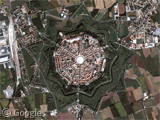
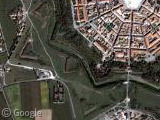
Palmanova, Italy (Wikipedia)
Cannons were most effective when they were fired perpendicular to the walls of the building under attack, and the star shaped design meant that to best position their weapons, attacking forces would have enter the space between the points of the star - where they would be fired on from both sides!
The judicious use of moats could further thwart the attacking forces, as demonstrated superbly here at Naarden, Netherlands.
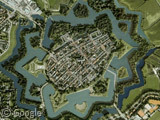
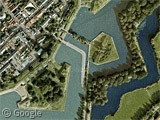
Naarden, Netherlands (Wikipedia)
By the late seventeenth-century star forts reached the pinnacle of their development, as shown by this complicated example in Bourtange, Netherlands, which has been fully restored to how it would have been in 1742. Here we can see that the design provides defence in depth, with tiers of ramparts that an attacker would have had to overcome to be in with a chance of taking the fort.
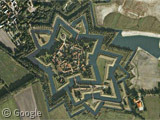
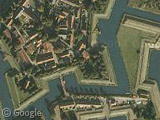
Bourtange, Netherlands (Wikipedia)
This ingenious design quickly became the gold standard for defensive forts, and went on to spread across Europe and the Americas:
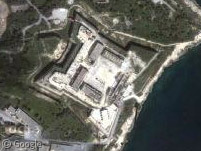
Fort Manoel, Malta (Wikipedia)
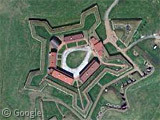
Fort McHenry, Maryland (Wikipedia)
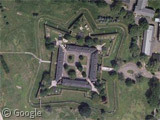
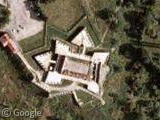
Fort Jay (Wikipedia) and Fort Ticonderoga (Wikipedia), New York
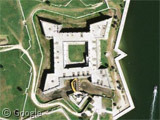
Castillo de San Marcos, Florida (Wikipedia)
The design even reached South Africa, where today the Castle of Good Hope can be seen right in the middle of the city! It used to be on the coast, but land reclamation allowed the city to expand around it.
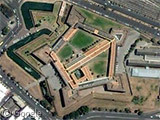
Castle of Good Hope, Cape Town, South Africa (Wikipedia)
In the nineteenth century the development of the exploding shell changed the nature of defensive fortifications forever, and the star fort soon became utterly obsolete. Which is why several are today used for completely different purposes - like this example in Slovakia where they now spend their time trying to keep people inside rather than out.
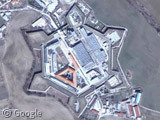
Leopoldov Prison, Slovakia (Wikipedia)
And finally, what is probably the world's most famous star fort isn't actually known for being a star fort at all - as Fort Wood is today the distinctive star-shaped pedestal underneath New York's Statue of Liberty.
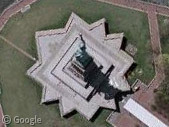
Fort Wood, New York (Wikipedia)
We've previously featured just one star fort several star forts, including Kastellet in Copenhagen, Citadel Hill in Canada, and the aforementioned Fort McHenry in Maryland. If that's not enough, there's a whole page about them at Wikipedia too.
Thanks to Dan W, Manuel Hewitt, RB, tom schuring, Stefano Bertolo and Federico Cretti.
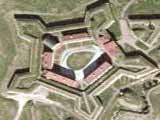

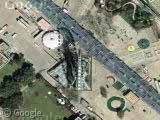
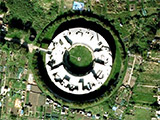
I thought, with some excitement, that this might be the longest post, by sights used, but, sadly, it was beaten to the punch by Street fight in Street View!
But I suppose this is the most ‘unique’ sights used! Either way, great post!
Hmmm, it would appear that the “latest sights” feature in the sidebar is better than me at finding star-forts we’ve previously featured…. scurries off to update the post
Reading over the old comments threads on the posts I just discovered (…) I found this awesome link to The International Star-Shaped Citadel Cities Summit. Pretty cool huh?
(Thanks to jef)
Any excuse for a booze-up/summit, those feindish citadel owners!
Looks like their club isn’t going too well though. They went from 10, to 9, to 5 cities attending the conference.
I noticed that too. I guess after the first one, they realised that it was the most pointless summit imaginable.
Rob, surely this wou…
NO! I’m so not biting.
Let me add one in Japan, Hokkaido : View Placemark
*My criticism of summits relating to star shaped miscellanea in no way points to my dislike of the objects themselves.
Yours Rob. 😉
There is also the famous ovular star fort in St. Petersburg, Russia
View Placemark
Fort Alexander
My bad, I meant:
http://en.wikipedia.org/wiki/Peter_and_Paul_Fortress
The burial place of many Russian Tsars and important location in the Bolshevik Revolution
You forgot the Citadel in Halifax, Nova Scotia, Canada.
here the most northern fort in the world !
View Placemark
Quite a bold claim Eric … but easily disproved, as Fort Charlotte in Lerwick is quite a ways further North: View Placemark
Neuf-Brisach is a nice example too :
View Placemark
The Citadel of Lille
View Placemark
this is Sabbioneta, in Italy, one of the most famous citadel shaped city in northen Italy
https://www.googlesightseeing.com/maps?p=&c=&t=k&hl=en&ll=44.997886,10.490828&z=15
an this is “Cittadella”, in Parma, my city, was a fort, and now is a park!
https://www.googlesightseeing.com/maps?p=&c=&t=k&hl=en&ll=44.792313,10.332084&z=16
There’s another: View Placemark
Very interesting star-shaped building from 16th century is in czech republic. It’s called letohrádek hvězda // folly star =). It’s located near Prague. And it’s not a fortress or citadel.
Placement: View Placemark (50.0836486577,14.3263404131)
what about this star in Copenhagen, Denmark
Kastellet
Quebec City Citadelle shoud be part of the group even if it’s not a perfect star shape because of the Diamond Cape hill.
View Placemark
I like the flower shape castles better:
https://www.googlesightseeing.com/maps?p=&c=&t=k&hl=en&ll=51.219502,1.403632&z=18
Deal, Kent
Check out Fort Negley. It’s a double star shaped Civial War era fort. It was built by the Union using a workforce of newly freed black slaves.
The City where i live (Livorno, Italy) was projected in 1576 as a “Star Fort Megapost”, like you can see today from the “Fosso Reale”. Link to the fortifications in the italian Wikipedia.
View Placemark (43.55085,10.309725)
That looks like a mighty nice yacht in the dock to the Southwest of the fort in Livorno: View Placemark Wonder if it is this one (which was built in Livorno in 2005…): http://www.charterworld.com/index.html?sub=yacht-charter&charter=luxury-yacht-galaxy-1009
Some forts remains in Paris’ suburbs. The former fort system was designed during the 19th century (see this german postcard from Wikipedia showing a map of the forts near Paris.
Some forts: – Fort du Mont Valérien: View Placemark (48.873367,2.213123) – Fort d’Ivry: View Placemark (48.802143,2.38987) – Fort de Charenton: View Placemark (48.808418,2.42933) – Fort de Rosny: View Placemark (48.869853,2.47437) – Fort d’Aubervilliers: View Placemark (48.910936,2.407122) – Fort de l’Est: View Placemark (48.931184,2.371416)
Antwerp has a string of them still existant: 2., 3., 4., 5., 6., 7., 8.,
Here are a couple stars, anyone know what they are all about? https://www.googlesightseeing.com/maps?p=&c=&t=k&hl=en&ll=51.391907,1.386343&z=19
Just to the south of Ben’s flower fort is another https://www.googlesightseeing.com/maps?p=&c=&t=k&hl=en&ll=51.200396,1.402382&z=18
and to the south of that flower fort, here is a whole stretch of shoreline with all sorts of star and various other fortifications. https://www.googlesightseeing.com/maps?p=&c=&t=k&hl=en&ll=51.127553,1.313295&z=14 https://www.googlesightseeing.com/maps?p=&c=&t=k&hl=en&ll=51.128845,1.322479&z=16 http://maps.live.com/default.aspx?v=2&FORM=LMLTSN&cp=shnf1yh393vg&style=b&lvl=1&tilt=-90&dir=0&alt=-1000&scene=4265422&phx=0&phy=0&phscl=1&encType=1 https://www.googlesightseeing.com/maps?p=&c=&t=k&hl=en&ll=51.129472,1.321227&z=19 https://www.googlesightseeing.com/maps?p=&c=&t=k&hl=en&ll=51.122815,1.307738&z=18 https://www.googlesightseeing.com/maps?p=&c=&t=k&hl=en&ll=51.118394,1.299369&z=16
Here’s a cool fort south of the others https://www.googlesightseeing.com/maps?p=&c=&t=k&hl=en&ll=51.048891,1.036679&z=19
And futher south, a flower? a turtle? a fort? https://www.googlesightseeing.com/maps?p=&c=&t=k&hl=en&ll=50.933615,0.733584&z=19
I don’t think this one has been posted yet. Fort Cumberland (England) http://en.wikipedia.org/wiki/Fort_Cumberland_%28England%29 https://www.googlesightseeing.com/maps?p=&c=&t=k&hl=en&ll=50.788439,-1.033723&z=16
Here is an interesting fort design, round with star type points, Fort Brockhurts http://en.wikipedia.org/wiki/Fort_Brockhurst https://www.googlesightseeing.com/maps?p=&c=&t=k&hl=en&ll=50.814667,-1.153814&z=19
And half a star fort, with some crazy imagery overlay issues. https://www.googlesightseeing.com/maps?p=&c=&t=k&hl=en&ll=50.777626,-1.13289&z=17
I’m not gonna post LiveMaps Links to all these, put here is a general area shot of Portsmouth, check out the birdseye view of these places, really cool! http://maps.live.com/default.aspx?v=2&FORM=LMLTSN&cp=50.798015~-0.984993&style=h&lvl=12&tilt=-90&dir=0&alt=-1000&scene=4337149&phx=0&phy=0&phscl=1&encType=1
There all kinds of forts and castles around Portsmouth Harbour, I definitely recommend looking around and checking them out.
This has nothing to do with forts but I saw it and thought I’d point it out. Perhaps the worlds largest airplane prop. here https://www.googlesightseeing.com/maps?p=&c=&t=k&hl=en&ll=51.098568,1.205921&z=19
Wow, very long comment haha, my apologies.
The design even reached South America. I think this fort, (Fortaleza de Santa Teresa in Rocha, Uruguay) is far far away from the others. View Placemark There are two more in Uruguay, but they’re not in hi res yet.
Perhaps the oldest and largest of all Nikosia Old City
And around Portsmouth harbour: 1. 2. “3. “4. “5. “6. “7. “8. The interesting thing here is that they obviously gave up the classic Vauban structure as they went along…
Here is a nice fort in Essex, UK
Tilbury Fort
http://en.wikipedia.org/wiki/Tilbury_Fort
Another one, this is in Jaca, in Spain:
View Placemark
Lucca Italy, very well preserved starish walled city View Placemark
Don’t Forget Neuf Brisach
View Placemark
Better late than never: that star-fort at Naarden is the end of a whole string surrounding Amsterdam: 1. , 2. , 3. , 4. , 5. , 6. , 7. , 8. , 9. , 10. , 11. , 12. , 13. , 14. , 15. , 16. , 17. , 18. , 19. , 20. , 21. , 22. , 23. , 24. , 25. , 26. , 27. , 28. , 29. , 30. , 31. , 32. ,
In Frederksted on St. Croix,US Virgin Islands is Fort Frederik.
https://www.googlesightseeing.com/maps?p=&c=&t=h&hl=en&ll=17.715086,-64.883414&z=18
Per Wikipedia, this was built between 1752 and 1760 by Denmark.
Have a look at
http://obromley.deoss.net/web/concept/star_fort.htm
for further pictures and old drawings and text re. star forts
Here is also one from Arad, Romania: https://www.googlesightseeing.com/maps?p=&c=&t=h&hl=en&ll=46.169162,21.333947&z=15
The thing that struck me as odd about the Amsterdam ring is that it stopped at the Ijselmeer – although from one point of view, an inland sea is rather more effective than a string of forts, it was not unknown to have frozen over during the mini ice-age which occurred in the seventeenth century, within living memory of when that string was built. Consequently, it didn’t come as a great surprise to find another one on the east side: 1. 2. – housing the Anton Pieck Museum, and then I lose the trace.
There’s also another one between the start of the line in the earlier post, to the north of Amsterdam, and the town itself: 1., 2., 3. Just the trace of a bastion of something bigger, before joining up with the forts in the earlier posting